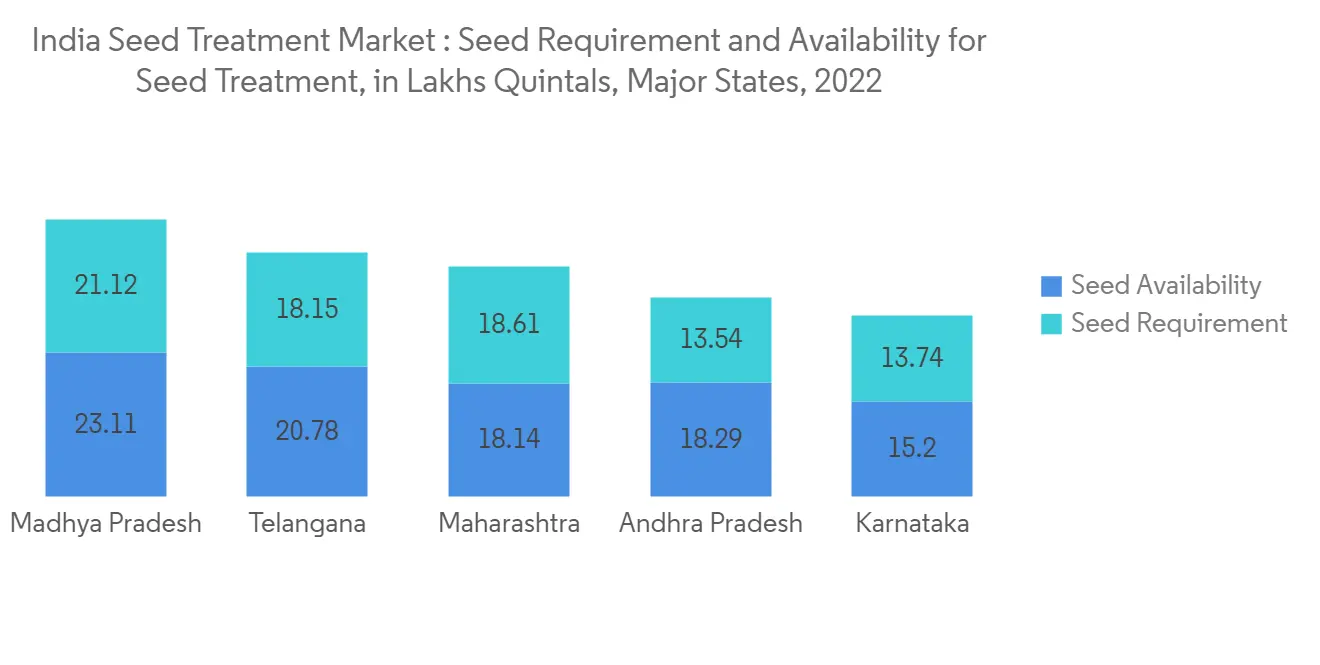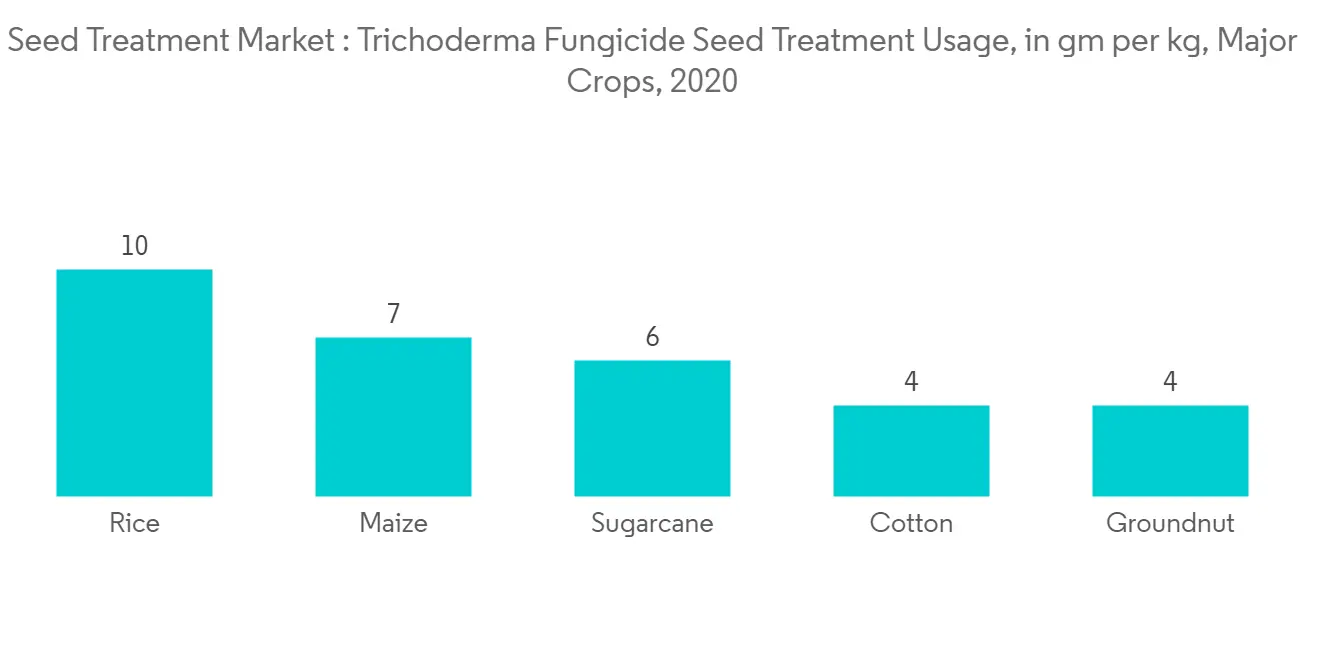PUBLISHER: Mordor Intelligence | PRODUCT CODE: 1329789

PUBLISHER: Mordor Intelligence | PRODUCT CODE: 1329789
India Seed Treatment Market Size & Share Analysis - Growth Trends & Forecasts (2023 - 2028)
The India Seed Treatment Market size is estimated at USD 88.64 million in 2023, and is expected to reach USD 122.01 million by 2028, growing at a CAGR of 6.60% during the forecast period (2023-2028).
Key Highlights
- The increasing adoption rate of modern technologies, including biological seed treatment for corn, across the country is leading companies to focus on seed innovations. The non-chemical/biological segment is witnessing a robust growth rate. The Indian government has started providing subsidies for the procurement of chemical seed treatment in some of its states, such as Odisha. According to the data from the Government of Odisha, the farmers are receiving subsidy assistance of INR 100 per hectare for the procurement of chemical seed treatment. The provision of subsidies is anticipated to encourage investments in chemical seed treatment in the country.
- The majority of the farmers in the country use microbial species such as Trichoderma and chlorpyrifos for treating seeds of crops such as rice. For managing the bakanae disease in the basmati rice variety in India, the combination of carbendazim and Trichoderma viride is the most preferred seed treatment method. For maize, the Indian farmers use fungicide-treated seed, with a preference for Trichoderma viride and Trichoderma harzianium.
- Several state governments are taking initiatives in order to make farmers aware of the use of seed treatment and enhance their motivation toward agricultural practices. For instance, the Government of Madhya Pradesh launched a spiral grader and seed treatment drum program to provide training to the less-knowledgeable farmers in 1,000 villages and boost the cultivation of crops like soybean. SoyRhizo & Nrow granular 8 lbs with Cruiser Maxx Vibrance, Evergol Energy Stress Shield, or Acceleron are the major soybean seed treatment methods adopted in the country.
- Also, credit-linked back-ended capital subsidy is provided at the rate of 25% of the project cost subject to a maximum limit of INR 25 lakhs per unit on seed infrastructure development. Private Companies, individual entrepreneurs, self-help groups, seed co-operatives, and partnership farms are eligible for subsidy. The component is implemented through Nationalised Banks/Scheduled Commercial Banks and National Co-operative Development corporations (NCDC). The assistance is for the creation of infrastructure facilities relating to seed cleaning, grading, processing, seed treating, packaging, and storage units as well as for seed testing facilities.
India Seed Treatment Market Trends
Seed Treatment as a Solution to Enhance Yield
Farmers are increasingly considering seed treatment as a mode to protect investments made on good quality seeds due to increased regulatory issues relating to fumigation and foliar application of pesticides. Seed diseases and volatile environments are a few major challenges farmers face that decrease crop yield. Therefore, this boosts the demand for seed coatings as coating the seed with pesticides, fertilizers, plant growth regulators, and others helps in accelerating seed performance and germination. The cost of seeds is expected to increase due to the demand for high-quality seeds with desirable agronomic traits. Both companies and farmers are ready to spend on seed treatment solutions in order to save high-quality seeds. Framers are trying to cut down on operating costs by selecting seeds that do not require multiple doses of chemicals. The initial protection of these engineered seeds is ensured by using seed treatment products.
Seed treatment has become necessary due to changing trends and growers' 100% seed emergence expectation, even during unfavorable conditions. Top players in the market are focusing on the development of superior quality seeds through modern breeding techniques, thereby increasing the seed cost. Replanting seeds due to poor germination and insect attack is expensive. Moreover, the high cost of labor requirements is associated with overall cost. According to the Food and Agriculture Organization, the total crop yield of cereals accounted for 34,788 hg/ha in 2021, which is higher than the previous year at 34,070 ha/hg. Hence to meet the growing demand, farmers need quality seeds that are well-treated to enhance the yield in limited harvested areas.
Various regulations and government agencies are encouraging the use of seed treatments to increase the marketability of seeds and help companies expand in new markets. Accordingly, the Indian government has launched a countrywide campaign to ensure 100% seed treatment in all important crops. Pesticide industry associations, Agricultural Technology Management Agency (ATMA), Central Integrated Pest Management Centre (CIPMC), Krishi Vigyan Kendra Knowledge Network (KVKs), Farmers Clubs, State Agricultural Universities (SAUs), NGOs, etc., played an essential role in the campaign, to encourage complete seed treatment. Thus, based on the aforementioned factors, the high cost of quality seeds and fluctuating arable land make seed treatment one of the viable options for enhancing yield.

Fungicides Seed Treatment Dominates the Market
Fungicide seed treatment is used to control fungal pathogens that are seed surface-borne, internally seed-borne fungal pathogens such as the loose smut fungi of cereals, and soilborne pathogens that attack germinating seeds and seedlings both pre- and post-emergence. With the increasing demand for high-quality seeds with desirable agronomic traits, fungicides seed treatment is done to protect the seeds from any external damage or pest attack. Carboxy, Thiram, and Bavistin are the commonly used fungicides for seed treatment in India in many crops. Captan fungicide is also used as a seed dresser in various horticultural crops.
Loose smut is one of the most common fungal diseases affecting wheat cultivation in the country. It can hamper the growth of the emerging seedling and even damage the plant. Fungicidal seed treatment products are found to be most effective against seed-borne diseases like loose smut. This has increased their use in the major wheat-growing regions in the country. Therefore, based on the aforementioned factors, increased usage of fungicides on cotton, wheat, rice, and vegetables is expected to drive the market studied in the future. Raxil is a fungicide seed treatment product developed by Bayer CropScience that has been used by Indian farmers for many years for the control of loose smut disease in wheat. Raxil Easy is an advanced FS (flowable concentrate for seed treatment) formulation that sticks uniformly on the seed, leading to increased efficacy in controlling the disease. The product's active ingredient can control pathogens present inside the seed and those found on the outer surface.

India Seed Treatment Industry Overview
The Indian seed treatment market is highly consolidated, with few major players dominating the market. Bayer Crop Science AG, Syngenta, UPL Limited, BASF SE, Indofill Industrial Limited, and Adama Agricultural Solutions Limited are some of the prominent players who are operating in the market. The major players in the market are expanding their presence to strengthen their operations. Mergers and acquisitions are the strategies most adopted by prominent players to consolidate their positions in the market.
Additional Benefits:
- The market estimate (ME) sheet in Excel format
- 3 months of analyst support
TABLE OF CONTENTS
1 INTRODUCTION
- 1.1 Study Assumptions & Market Definition
- 1.2 Scope of the Study
2 RESEARCH METHODOLOGY
3 EXECUTIVE SUMMARY
4 MARKET DYNAMICS
- 4.1 Market Overview
- 4.2 Market Drivers
- 4.3 Market Restraints
- 4.4 Porter's Five Forces Analysis
- 4.4.1 Bargaining Power of Suppliers
- 4.4.2 Bargaining Power of Buyers
- 4.4.3 Threat of New Entrants
- 4.4.4 Threat of Substitutes
- 4.4.5 Intensity of Competitive Rivalry
5 MARKET SEGMENTATION
- 5.1 Chemical Origin
- 5.1.1 Synthetic
- 5.1.2 Biological
- 5.2 Product Type
- 5.2.1 Insecticides
- 5.2.2 Fungicides
- 5.2.3 Other Product Types
- 5.3 Application Technique
- 5.3.1 Seed Coating
- 5.3.2 Seed Pelleting
- 5.3.3 Seed Dressing
- 5.4 Crop Type
- 5.4.1 Grains and Cereals
- 5.4.2 Pulses and Oilseeds
- 5.4.3 Fruits and Vegetables
- 5.4.4 Commercial Crops
- 5.4.5 Other Crop Types
6 COMPETITIVE LANDSCAPE
- 6.1 Most Adopted Strategies
- 6.2 Market Share Analysis
- 6.3 Company Profiles
- 6.3.1 Syngenta
- 6.3.2 Bayer CropScience AG
- 6.3.3 BASF SE
- 6.3.4 Corteva Agriscience
- 6.3.5 Adama Ltd.
- 6.3.6 UPL Limited
- 6.3.7 Incotec Group BV
- 6.3.8 Rallis India Limited
- 6.3.9 FMC Corporation
- 6.3.10 Sumitomo chemical India Limited
- 6.3.11 Indofil Industries Limited
- 6.3.12 Crystal Crop Protection Ltd
- 6.3.13 Dhanuka Agritech Ltd
- 6.3.14 GSP Crop Science Private Limited
7 MARKET OPPORTUNITIES AND FUTURE TRENDS




